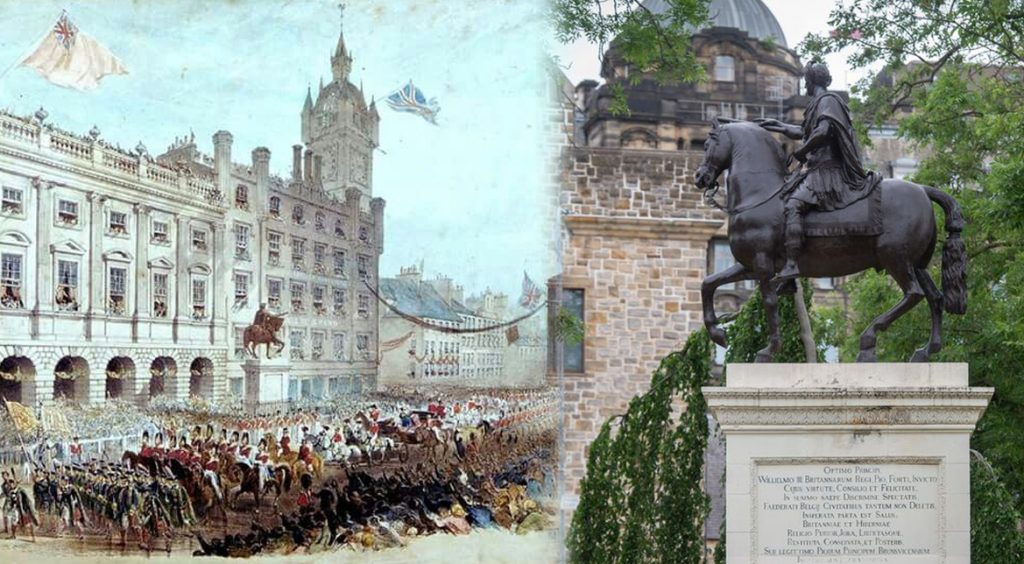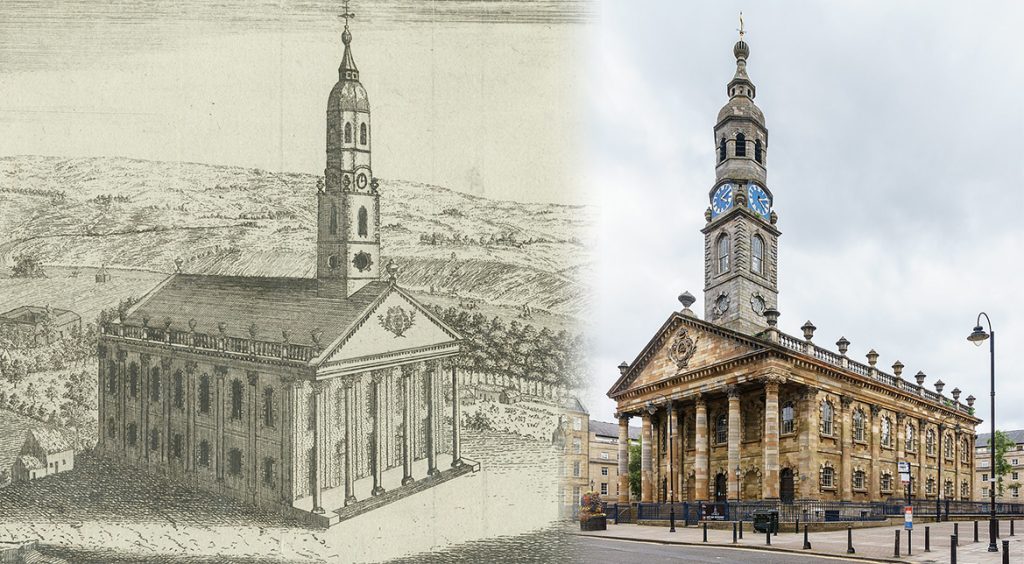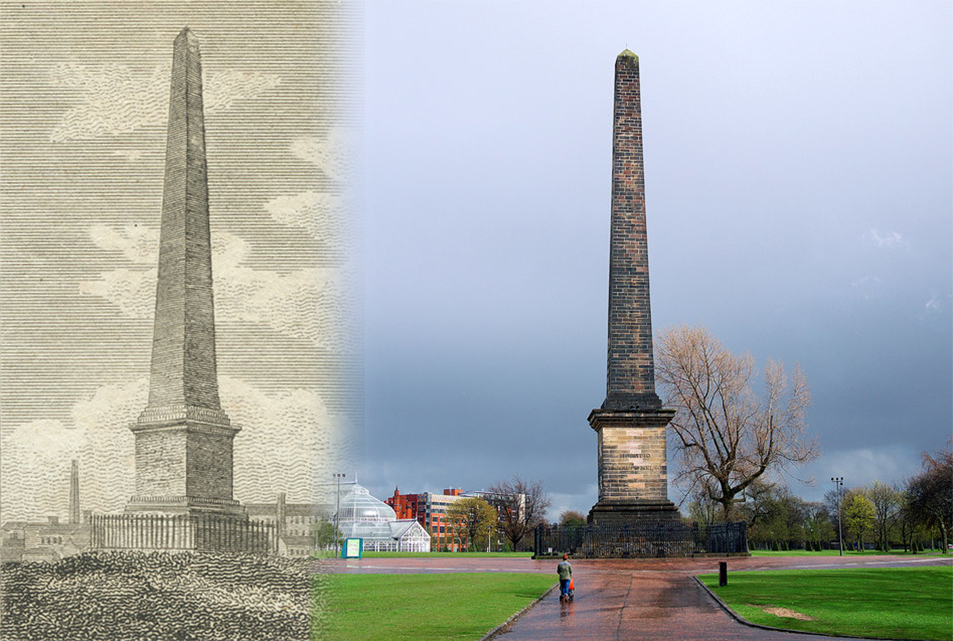
By Craig Lamont
The Cultural Memory of Georgian Glasgow is the first book-length study of a long-neglected period in the history of Scotland’s largest city. It covers topics such as the Scottish Enlightenment and Empire, including the slave trade, revealing Glasgow’s central position in eighteenth-century history. My book makes use of cultural memory theory to bring this obscured history to life. This entails the reading of literature, private correspondence, newspaper reports, as well as artworks and statues which tell the story of how the Georgians and Victorians saw themselves. While ‘collective memory’ is something we can all remember together through lived experience, ‘cultural memory’ relies on a prism of impressions gathered throughout time. To stroll through Glasgow today you would encounter a fine, mostly Victorian city. The wear and tear of heavy industry and a huge population have meant that few of Glasgow’s Georgian structures have survived. But they can be found. Below are five key sites, all of which can be seen today, which tell the story of Georgian Glasgow.
Why not view these locations on a map?

1. Equestrian Statue of William of Orange (1734), High Street
William of Orange is a central figure in Scottish history, particularly religious history. His memory is cherished by some (‘King Billy’) and loathed by others: a microcosm of the sectarian tensions that are very much alive in Glasgow today. You can see his statue today on High Street, near the Provand’s Lordship and St. Mungo’s Cathedral. But it was originally located on Argyle Street where it was unveiled in 1734. According to John M‘Ure, author of Glasgow’s first published history book (1736), it was a gift to the city by the Countryman Governor John McCrae. M‘Ure also wrote a poem in praise of the statue, which offers a glimpse into the mind of loyalist Glaswegians in the Georgian era:
By [William] the widowed Lands no more bemoan;
A broken Lineage and undoubtful Throne,
He fixt Succession in our Georges Line,
Whereby our future Peace the Source we find…
Suffice to say, when the Jacobites visited Glasgow in 1745, they were not made to feel at all welcome. Throughout the eighteenth century, this was the only new portrait statue to adorn the streets of Glasgow. Widespread commemoration was very much a nineteenth-century phenomenon.

2. St. Andrew’s in the Square (1756), Saltmarket
Work commenced on this stunning church in 1739, on a site which once formed part of the open green behind the Saltmarket. The architect, Allan Dreghorn, based the design on St. Martin-in-the-Fields (1726), in London’s Trafalgar Square. When completed in the 1750s it served as St. Andrew’s Parish Church, with services running through to the 1990s, and the buildings around it were added towards the end of the eighteenth century. In Glasgow, Past and Present (1851) it is said that, ‘excepting the Cathedral’, the building is ‘the most beautiful specimen of ecclesiastical architecture we have’ (p. 97). Managed today by the Glasgow Building Preservation Trust, this amazing Georgian church is almost hidden in plain sight, in one of Glasgow’s oldest quarters.

3. Trades Hall (1794), 85-91 Glassford Street
The Trades Hall is one of the few remaining Georgian buildings in Glasgow and the only remaining building in the city designed by the renowned architect Robert Adam (1728-92). Work completed in 1794, on the site of the merchant John Glassford’s manor house (hence the street name). It remains functional as the home to the Trades House of Glasgow, which, established in 1605, represents each of the fourteen Incorporated Crafts in the city. They are: Hammermen, Tailors, Cordiners, Maltmen, Weavers, Bakers, Skinners & Glovers, Wrights, Coopers, Fleshers, Masons, Gardeners, Barbers, and Bonnetmakers & Dyers. Before the Hall was built, the Trades House was situated further north, in the Almshouse on High Street. Today, the building is used for events such as weddings and conferences.

4. The Nelson Monument (1806), Glasgow Green
Horatio Nelson, 1st Viscount Nelson (b. 1758) was fatally wounded in the Battle of Trafalgar (1805). Within a year Glasgow proudly boasted the first commemorative shrine to his name, in the form of a 144ft high obelisk in Glasgow Green. Other monuments in the British Isles soon followed, and many poems, songs and artworks were created to remember Nelson. In August 1810 the Glasgow monument was struck by lightning, causing some damage to the stonework. The Glasgow artist John Knox (1778-1845) created a painting of this dramatic moment. It is very important today because it marks the beginning of a wave of commemoration – particularly of soldiers, statesmen and monarchs – that soon changed the civic landscape of Glasgow. Many major cities across Europe were soon peppered with statues of the ‘great and good’, and debates rage today as to whether or not these commemorated men best represent our values.

5. St. Andrew’s Roman Catholic Chapel (Cathedral, 1816), 168 Clyde Street
Following many years of exclusion, the Roman Catholic population of Glasgow began to increase in the nineteenth century. Before the construction of this building, Catholics would practice in small, private chapels on the High Street. Work on the new building began in 1814, to the design of James Gillespie Graham, at the high cost of £13,000. The first service is said to have taken place on Sunday, 22 December 1816. Situated on the Clyde, it was described in Nelson’s Hand-Book to Scotland: For Tourists (1860) as ‘a large, brilliant, modern edifice, in florid Gothic, consisting of nave and aisles, and bristling with slender towers and crocketted pinnacles’ (p. 195). Illustrations of the building show the old Town’s Hospital of Glasgow (1733), no longer extant, which stood beside it. It is now named the Metropolitan Cathedral of St Andrew. Along with St. Andrew’s in the Square, and St. Andrew’s-by-the-Green, this is the third important ‘St. Andrew’s’ church in Glasgow.

Craig Lamont is a Research Associate in the Centre for Robert Burns Studies at the University of Glasgow. His work in eighteenth-century Scottish literature and book history has appeared in key journals.

The Cultural Memory of Georgian Glasgow
The first interdisciplinary exploration of eighteenth-century Glasgow. This book approaches Glasgow’s history as a guide to the cultural memory of the city read through traditional historical and literary analysis. It engages with primary sources such as contemporary literature, journalism, and ephemera from a range of institutions and archives and sets out a methodological blueprint for new research into other cities or civic spaces.





